Evaluation of the Mechanical, Physical, and Anti-Fungal Properties of Flax Laboratory Papersheets with the Nanoparticles Treatment
Abstract
1. Introduction
2. Materials and Methods
2.1. Chemicals
2.2. Preparation of Nanocomposites
2.3. Morphological Analysis of the Prepared Nanocomposites
2.4. Flax Material and the Soda–Anthraxquinone Pulping Process
2.5. Chemical Analysis
2.6. Pulp Additives
2.7. Sheet Formation and Papersheet Testing
2.8. In Vitro Inhibition of Fungal Infestation
2.9. Scanning Electron Microscopy
2.10. Statistical Analysis
3. Results
3.1. Morphological Analyses (TEM) of the Prepared Nanomaterials
3.2. Chemical Composition of the Flax Plant and Pulp Properties
3.3. Mechanical and Physical Properties of the Papersheets
3.4. Biological Activity of the Flax Papersheets
4. Discussion
5. Conclusions
Author Contributions
Funding
Acknowledgments
Conflicts of Interest
References
- Agarwal, M.; Lvov, Y.; Varahramyan, K. Conductive wood microfibres for smart paper through layer-by-layer nanocoating. Nanotechnology 2006, 17, 5319–5325. [Google Scholar] [CrossRef]
- Ghule, K.; Ghule, A.V.; Chen, B.-J.; Ling, Y.-C. Preparation and characterization of ZnO nanoparticles coated paper and its antibacterial activity study. Green Chem. 2006, 8, 1034–1041. [Google Scholar] [CrossRef]
- Koga, H.; Kitaoka, T.; Wariishi, H. In situ synthesis of silver nanoparticles on zinc oxide whiskers incorporated in a paper matrix for antibacterial applications. J. Mater. Chem. 2009, 19, 2135–2140. [Google Scholar] [CrossRef]
- Maryan, A.S.; Montazer, M.; Rashidi, A. Introducing old-look, soft handle, flame retardant, and anti-bacterial properties to denim garments using nano clay. J. Eng. Fibers Fabr. 2013, 8, 68–77. [Google Scholar] [CrossRef]
- Brodin, F.W.; Gregersen, Ø.W.; Syverud, K. Cellulose nanofibrils: Challenges and possibilities as a paper additive or coating material—A review. Nord. Pulp. Pap. Res. J. 2014, 29, 156–166. [Google Scholar] [CrossRef]
- Rastogi, V.K.; Samyn, P. Bio-based coatings for paper applications. Coatings 2015, 5, 887–930. [Google Scholar] [CrossRef]
- Nicu, R.; Bobu, E.; Desbrieres, J. Chitosan as cationic polyelectrolyte in wet-end papermaking systems. Cellul. Chem. Technol. 2011, 45, 5–111. [Google Scholar]
- Diab, M.; Curtil, D.; El-shinnawy, N.; Hassan, M.L.; Zeid, I.F.; Mauret, E. Biobased polymers and cationic microfibrillated cellulose as retention and drainage aids in papermaking: Comparison between softwood and bagasse pulps. Ind. Crop. Prod. 2015, 72, 34–45. [Google Scholar] [CrossRef]
- Kjellgren, H.; Gällstedt, M.; Engström, G.; Järnström, L. Barrier and surface properties of chitosan-coated greaseproof paper. Carbohyd. Polym. 2006, 65, 453–460. [Google Scholar] [CrossRef]
- Chen, Z.; Zhang, H.; Song, Z.; Qian, X. Combination of glyoxal and chitosan as the crosslinking system to improve paper wet strength. BioResources 2013, 8, 6087–6096. [Google Scholar] [CrossRef]
- Fithriyah, N.H.; Erdawati. Influence of nanoparticles coating on paper durability. J. Eng. Sci. Technol. 2015, 10, 1–11, Special Issue on SOMCHE 2014 & RSCE 2014 Conference, 3 January. [Google Scholar]
- Hamzeh, Y.; Sabbaghi, S.; Ashori, A.; Abdulkhani, A.; Soltani, F. Improving wet and dry strength properties of recycled old corrugated carton (OCC) pulp using various polymers. Carbohyd. Polym. 2013, 94, 577–583. [Google Scholar] [CrossRef] [PubMed]
- Allan, G.G.; Fox, J.R.; Crosby, G.D.; Sarkanen, K.V. Chitosan, a Mediator for Fiber-Water Interactions in Paper; College of Forest Resources/University of Washington Press: Seattle, WA, USA, 1977; p. 125. [Google Scholar]
- Ashori, A.; Raverty, W.D.; Jalaluddin, H. Effect of chitosan addition on the surface properties of kenaf (Hibiscus cannabinus) paper. Iran Polym. J. 2005, 14, 807–814. [Google Scholar] [CrossRef]
- Vikele, L.; Laka, M.; Sable, I.; Rozenberga, L.; Grinfelds, U.; Zoldners, J.; Passas, R.; Mauret, E. Effect of chitosan on properties of paper for packaging. Cellul. Chem. Technol. 2017, 51, 67–73. [Google Scholar]
- Zemljič, L.F.; Valh, J.V.; Kreže, T. Preparation of antimicrobial paper sheets using chitosan. Cellul. Chem. Technol. 2017, 51, 75–81. [Google Scholar]
- Vellingiri, K.; Ramachandran, T.; Senthilkumar, M. Eco-friendly application of nano chitosan in antimicrobial coatings in the textile industry. Nanosci. Nanotechnol. 2013, 3, 75–89. [Google Scholar] [CrossRef]
- Gavhane, Y.N.; Gurav, A.S.; Yadav, A.V. Chitosan and Its Applications: A Review of Literature. Int. J. Res. Pharma Biomed. Sci. 2013, 4, 312–331. [Google Scholar]
- Ravi Kumar, M.N. A review of chitin and chitosan applications. React. Funct. Polym. 2000, 46, 1–27. [Google Scholar] [CrossRef]
- Nada, A.M.A.; El-Sakhawy, M.; Kamel, S.; Eid, M.A.M.; Adel, A.M. Effect of chitosan and its derivatives on the mechanical and electrical properties of paper sheets. EGY J. Solid 2005, 28, 359–377. [Google Scholar]
- Shen, J.; Song, Z.; Qian, X.; Ni, Y. A review on use of fillers in cellulosic paper for functional applications. Ind. Eng. Chem. Res. 2010, 50, 661–666. [Google Scholar] [CrossRef]
- Balan, T.; Guezennec, C.; Nicu, R.; Ciolacu, F.; Bobu, E. Improving barrier and strength properties of paper by multi-layer coating with bio-based additives. Cellul. Chem. Technol. 2015, 49, 607–615. [Google Scholar]
- Zhang, G.; Liu, Y.; Morikawa, H.; Chen, Y. Application of ZnO nanoparticles to enhance the antimicrobial activity and ultraviolet protective property of bamboo pulp fabric. Cellulose 2013, 20, 1877–1884. [Google Scholar] [CrossRef]
- Völkel, L.; Ahn, K.; Hähner, U.; Gindl Altmutte, W.; Potthast, A. Nano meets the sheet: Adhesive free application of nanocellulosic suspensions in paper conservation. Herit. Sci. 2017, 5, 23. [Google Scholar] [CrossRef]
- Duran, N.; Lemes, A.P.; Seabra, A.B. Review of Cellulose Nanocrystals Patents: Preparation, Composites and General Application. Rec. Pat. Nanotechnol. 2012, 6, 16–28. [Google Scholar] [CrossRef]
- Chakraborty, A.; Sain, M.; Kortschot, M. Cellulose microfibrils: A novel method of preparation using high shear refining and cryocrushing. Holzforschung 2005, 59, 102–107. [Google Scholar] [CrossRef]
- Schlosser, H. Nano disperse cellulose and nano fibril cellulose—New products for the preparation and improvement of paper and cartons. Wochenbl. Für Pap. 2008, 136, 252–260. [Google Scholar]
- Hassan, R.R.; Mohamed, W.S. Effect of Methyl methacrylate/hydroxyethyl methacrylate copolymer on mechanical properties optical and long-term durability of paper under accelerated ageing. Int. J. Conserv. Sci. 2017, 8, 237–250. [Google Scholar]
- Hassan, R.R.; Mohamed, W.S. The impact of methyl methacrylate hydroxyethyl methacrylate loaded with silver nanoparticles on mechanical properties of paper. Appl. Phys. A 2018, 124, 551. [Google Scholar] [CrossRef]
- Traistaru, A.A.T.; Timar, M.C.; Campeanu, M.; Croitoru, C.; Sandu, I. Paraloid B72 versus Paraloid B72 with Nano-ZnO additive as consolidants for wooden artifacts. Mater. Plast. 2012, 49, 293–300. [Google Scholar]
- Tiralová, Z.; Reinprecht, L. Fungal Decay of Acrylate Treated Wood. In Proceedings of the 35th Annual Meeting: International Research Group on Wood Preservation, Ljubljana, Slovenia, 6–10 June 2004; p. 30357, Document No. IRG/WP. [Google Scholar]
- Pohleven, F.; Valantič, A.; Petrič, M. Resistance of consolidated deteriorated wood to wood decay fungi. In Proceedings of the IRG 44th Annual Meeting. IRG/WP, Stockholm, Sweden, 16–20 June 2013; p. e10812. [Google Scholar]
- Mansour, M.M.A.; Salem, M.Z.M. Evaluation of wood treated with some natural extracts and Paraloid B-72 against the fungus Trichoderma harzianum: Wood elemental composition, in-vitro and application evidence. Int. Biodeterior. Biodegrad. 2015, 100, 62–69. [Google Scholar] [CrossRef]
- Mansour, M.M.A.; Abdel-Megeed, A.; Nasser, R.A.; Salem, M.Z.M. Comparative evaluation of some woody trees methanolic extracts and Paraloid B-72 against phytopathogenic mold fungi Alternaria tenuissima and Fusarium Culmorum. Bioresources 2015, 10, 2570–2584. [Google Scholar] [CrossRef]
- Kalpana Srivastava, R.; Mishra, A.K.; Nair, M.V. Effective role of polymeric product in association with fungicide. Asiat. J. Biotechnol. Resour. 2011, 2, 553–557. [Google Scholar]
- MacLeod, J.M.; Fleming, G.J.; Kubes, G.J.; Bolker, H.I. The strength of kraft-AQ and soda-AQ pulps. Bleachable grade pulps. Tappi J. 1980, 63, 57–60. [Google Scholar]
- Tapanes, E.; Naranjo, M.E.; Aguero, C. Soda-anthraquinone pulping of bagasse. Nonwood Plant Fiber Pulping 1984, 15, 19–24. [Google Scholar]
- Sadawarte, N.S.; Dhawadkar, A.R.; Veeramani, P. High yield pulp from bagasse. Nonwood Plant Fiber Pulping 1986, 12, 31–33. [Google Scholar]
- Bhardwaj, N.K.; Goyal, S.K.; Gupta, A.; Upadhyaya, J.S.; Ray, A.K. Soda and Soda-Anthraquinone Pulping of Rice Straw. Appita J. 2005, 58, 180–185. [Google Scholar]
- Khristova, P.; Kordsachia, O.; Patt, R.; Karar, I.; Khider, T. Environmentally friendly pulping and bleaching of bagasse. Ind. Crop. Prod. 2006, 23, 131–139. [Google Scholar] [CrossRef]
- Al-Naamani, L.; Dobretsov, S.; Dutta, J.; Burgess, J.G. Chitosan-zinc oxide nanocomposite coatings for the prevention of marine biofouling. Chemosphere 2017, 168, 408–417. [Google Scholar] [CrossRef]
- Salem, M.Z.M.; Mansour, M.M.A.; Mohamed, W.S.; Ali, H.M.; Hatamleh, A.A. Evaluation of the antifungal activity of treated Acacia saligna wood with Paraloid B-72/TiO2 Nanocomposites against the growth of Alternaria tenuissima, Trichoderma harzianum, and Fusarium culmorum. Bioresources 2017, 12, l7615–l7627. [Google Scholar]
- Horie, C.V. Materials for Conservation: Organic Consolidants, Adhesives and Coatings, 2nd ed.; Butterworth-Heinemann: Oxford, UK, 2013; pp. 1–489. [Google Scholar] [CrossRef]
- Shafei, K.A.; Mustafa, A.B.; Mohamed, W.S. Grafting emulsion polymerization of glycidyl methacrylate onto leather by chemical initiation systems. J. Appl. Polym. Sci. 2008, 109, 3923–3931. [Google Scholar] [CrossRef]
- Azeredo, H.M.; Mattoso, L.H.; Avena-Bustillos, R.J.; Filho, G.C.; Munford, M.L.; Wood, D.; McHugh, T.H. Nanocellulose reinforced chitosan composite films as affected by nanofiller loading and plasticizer content. J. Food Sci. 2010, 75, N1–N7. [Google Scholar] [CrossRef] [PubMed]
- Syame, S.M.; Mohamed, W.S.; Mahmoud, R.K.; Omara, S.T. Synthesis of Copper-Chitosan Nanoparticles and its application in treatment of local pathogenic isolates bacteria. Orient. J. Chem. 2017, 33, 2959–2969. [Google Scholar] [CrossRef]
- Xu, Y.; Willis, S.; Jordan, K.; Sismour, E. Chitosan nanocomposite films incorporating cellulose nanocrystals and grape pomace extracts. Packag. Technol. Sci. 2018, 31, 631–638. [Google Scholar] [CrossRef]
- TAPPI Test Method; Tappi Press: Atlanta, GA, USA, 2015.
- Paper, Board and Pulps—Measurement of Diffuse Radiance Factor (Diffuse Reflectance Factor); International Organization for Standardization: Geneva, Switzerland, 2014; ISO 2469.
- SAS. User Guide: Statistics (Release 8.02); SAS Institute: Cary, NC, USA, 2001. [Google Scholar]
- Haldorai, Y.; Shim, J.-J. Chitosan-Zinc Oxide hybrid composite for enhanced dye degradation and antibacterial activity. Compos. Interfaces 2013, 20, 365–377. [Google Scholar] [CrossRef]
- Rowell, R.M. Handbook of Wood Chemistry and Wood Composites; Taylor and Francis: Boca Raton, FL, USA, 2005; p. 487. [Google Scholar]
- Monica, E.K.; Gellerstedt, G.; Henriksson, G. Wood Chemistry and Wood Biotechnology; Walter de Gruyter GmbH and Co. KG: Berlin, Germany, 2009; Volume 1, p. 320. [Google Scholar]
- Jahan, M.S.; Sabina, R.; Rubaiyat, A. Alkaline pulping and bleaching of Acacia auriculiformis grown in Bangladesh. Turk. J. Agric. For. 2008, 32, 339–347. [Google Scholar]
- Law, K.N.; Kokta, B.V.; Mao, C.B. Fibre morphology and sodasulphite pulping of switchgrass. Biores. Technol. 2001, 77, 1–7. [Google Scholar] [CrossRef]
- Barba, C.; Rosa, A.D.; Vidal, T.; Colom, J.F.; Farriol, X.; Montane, D. TCF bleached pulps from Miscanthus sinesis by the impregnation rapid steam pulping (IRSP) process. J. Wood Chem. Technol. 2002, 22, 249–266. [Google Scholar] [CrossRef]
- Finell, M.; Nilsson, C.; Olsson, R.; Agnemo, R.; Svensson, S. Briquetting of fractionated reed canary-grass for pulp production. Ind. Crop. Prod. 2002, 16, 185–192. [Google Scholar] [CrossRef]
- Shatalov, A.A.; Pereira, H. Influence of stem morphology on pulp and paper properties of Arundo donax L. reed. Ind. Crop. Prod. 2002, 15, 77–83. [Google Scholar] [CrossRef]
- Anapanurak, W.; Laemsak, N.; Veenin, T.; Atiwannapat, P. Alkali-oxygen pulping on steam-explosion pretreated bamboo species. Production, Design and Industrial Aspects. In Proceedings of the VIII World Bamboo Congress, Bangkok, Thailand, 16–19 September 2009; Available online: http://bambusc.org.br/wp-content/gallery/WBCVIII (accessed on 31 September 2009).
- Marrakchi, Z.; Khiari, R.; Oueslati, H.; Mauret, E.; Mhenni, F. Pulping and papermaking properties of Tunisian Alfa stems (Stipa tenacissima)—Effects of refining process. Ind. Crop. Prod. 2011, 34, 1572–1582. [Google Scholar] [CrossRef]
- Obi Reddy, K.; Uma Maheswari, C.; Shukla, M.; Muzenda, E. Preparation, chemical composition, characterization, and properties of Napier grass paper sheets. Sep. Sci. Technol. 2014, 49, 1527–1534. [Google Scholar] [CrossRef]
- Pääkkö, M.; Ankerfors, M.; Kosonen, H.; Nykänen, A.; Ahola, S.; Österberg, M.; Ruokolainen, J.; Laine, J.; Larsson, P.T.; Ikkala, O.; et al. Enzymatic hydrolysis combined with mechanical shearing and high-pressure homogenization for nanoscale cellulose fibrils and strong gels. Biomacromolecules 2007, 8, 1934–1941. [Google Scholar] [CrossRef]
- Siró, I.; Plackett, D. Microfibrillated cellulose and new nanocomposite materials: A review. Cellulose 2010, 17, 459–494. [Google Scholar] [CrossRef]
- Retulainen, E.; Nieminen, K.; Nurminen, I. Enhancing strength properties of Kraft and CTMP fiber networks. Appita J. 1993, 46, 3–38. [Google Scholar]
- Zou, Y.; Hsieh, J.S. Microfibrillated cellulose for papermaking. Presented at the International Conference on Nanotechnology for the Forest Products Industry, Knoxville, TN, USA, 13–15 June 2007. [Google Scholar]
- Bilodeau, M.; Bousfield, D.W. Potential applications of nanofibrillated cellulose in printing and writing papers. Presented at the TAPPI International Conference on Nanotechnology, Montreal, QC, Canada, 4–7 June 2012. [Google Scholar]
- Hamann, L. Wet-End Applications of NFC.; SUNPAP Workshop: Espoo, Finland, 2011. [Google Scholar]
- Madani, A.; Kiiskinen, H.; Olson, J.A.; Martinez, D.M. Fractionation of microfibrillated cellulose and its effects on tensile index and elongation of paper. Nord. Pulp Pap. Res. J. 2011, 26, 306–311. [Google Scholar] [CrossRef]
- Hentze, H.-P. VTT Technical Research Centre of Finland 2010. From Nanocellulose Science Towards Applications. Available online: http://www.vtt.fi/files/events/PulPaper10/NFCApplications_HPH.pdf (accessed on 25 August 2011).
- Kigawa, R.; Hayakawa, N.; Yamamoto, N.; Kawanobe, W.; Sano, C.; Aoki, S. Evaluation of mould resistance of various synthetic resins used in conservation of historic sites. Hozon Kagaku 2005, 44, 149–156. [Google Scholar]
- Hirano, S.N.N. Effects of chitosan, pectic acid, lysozyme, and chitinase on the growth of several phytopathogens. Agric. Biol. Chem. 1989, 53, 3065–3066. [Google Scholar]
- Zhong, Z.; Chen, R.; Xing, R.; Chen, X.; Liu, S.; Guo, Z.; Ji, X.; Wang, L.; Li, P. Synthesis and antifungal properties of sulfanilamide derivatives of chitosan. Carbohydr. Res. 2007, 342, 2390–2395. [Google Scholar] [CrossRef]
- Guerra-Sánchez, M.G.; Vega-Pérez, J.; Velázquez-del Valle, M.G.; Hernández-Lauzardo, A.N. Antifungal activity and release of compounds on Rhizopus stolonifer (Ehrenb.: Fr.) Vuill. by effect of chitosan with different molecular weights. Pestic. Biochem. Phys. 2009, 93, 18–22. [Google Scholar]
- Ziani, K.; Fernández-Pan, I.; Royo, M.; Mate, J.I. Antifungal activity of films and solutions based on chitosan against typical seed fungi. Food Hydrocoll. 2009, 23, 2309–2314. [Google Scholar] [CrossRef]
- Crawford, B.; Pakpour, S.; Kazemian, N.; Klironomos, J.; Stoeffler, K.; Rho, D.; Denault, J.; Milani, A.S. Effect of fungal deterioration on physical and mechanical properties of hemp and flax natural fiber composites. Materials 2017, 10, 1252. [Google Scholar] [CrossRef] [PubMed]
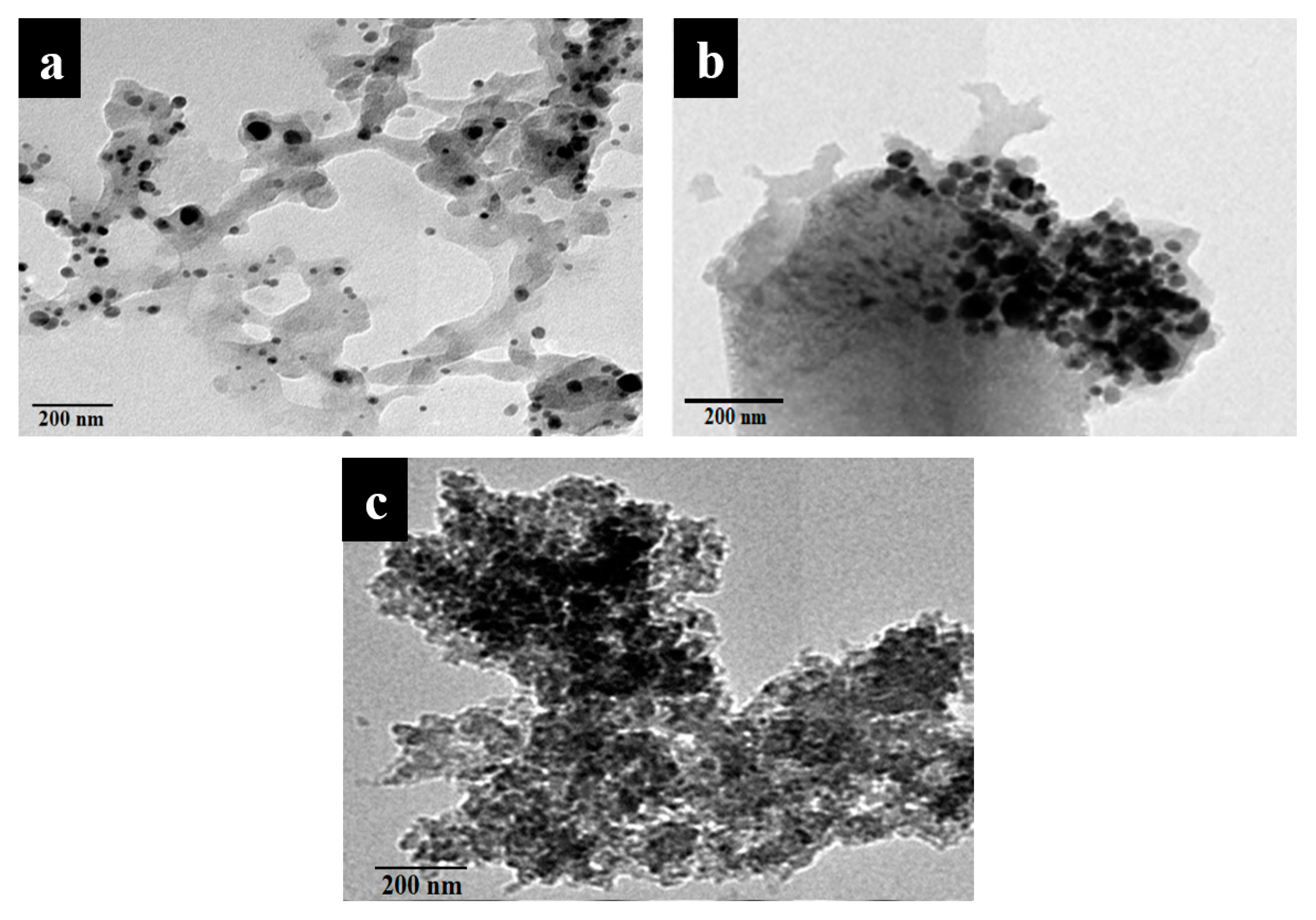
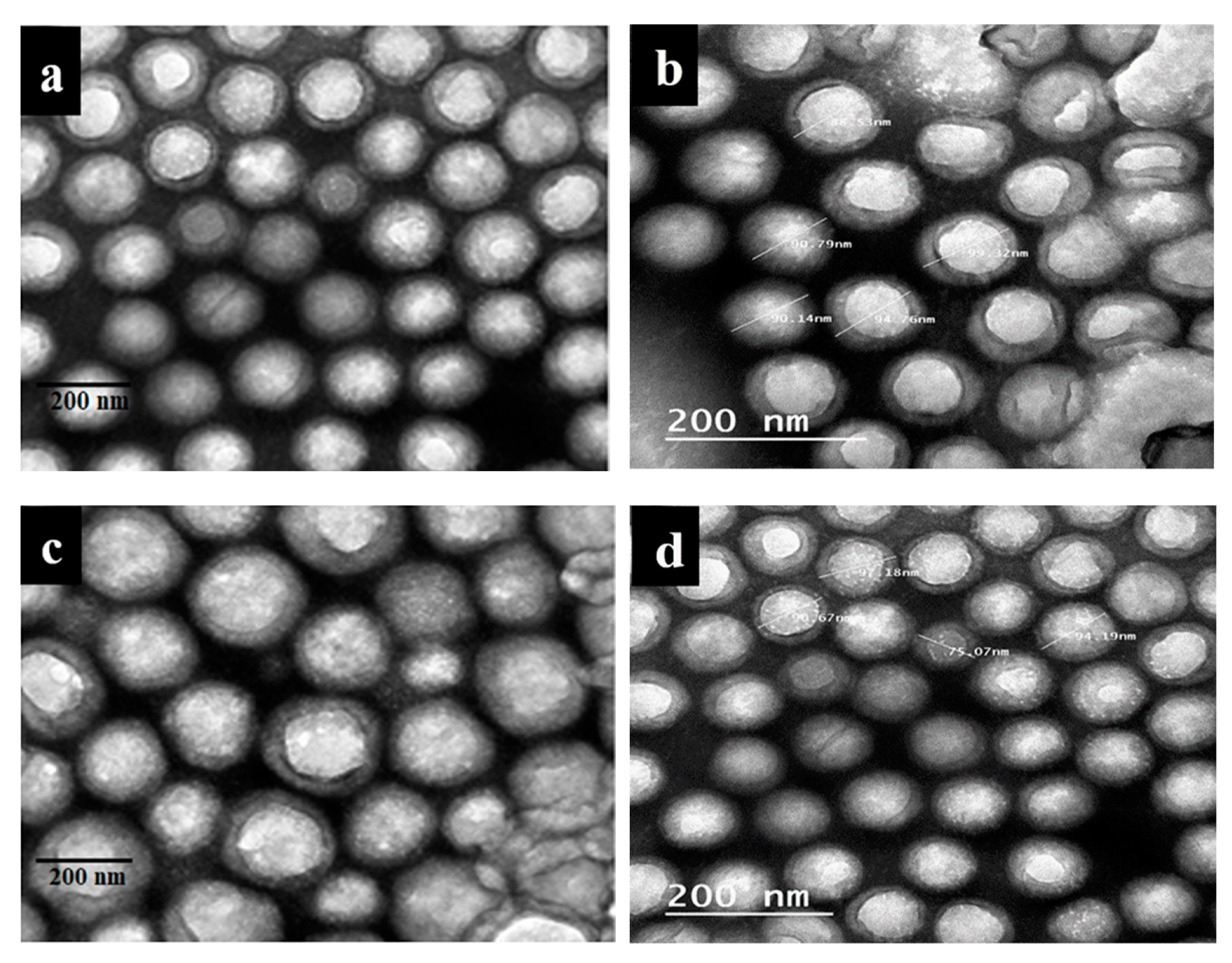
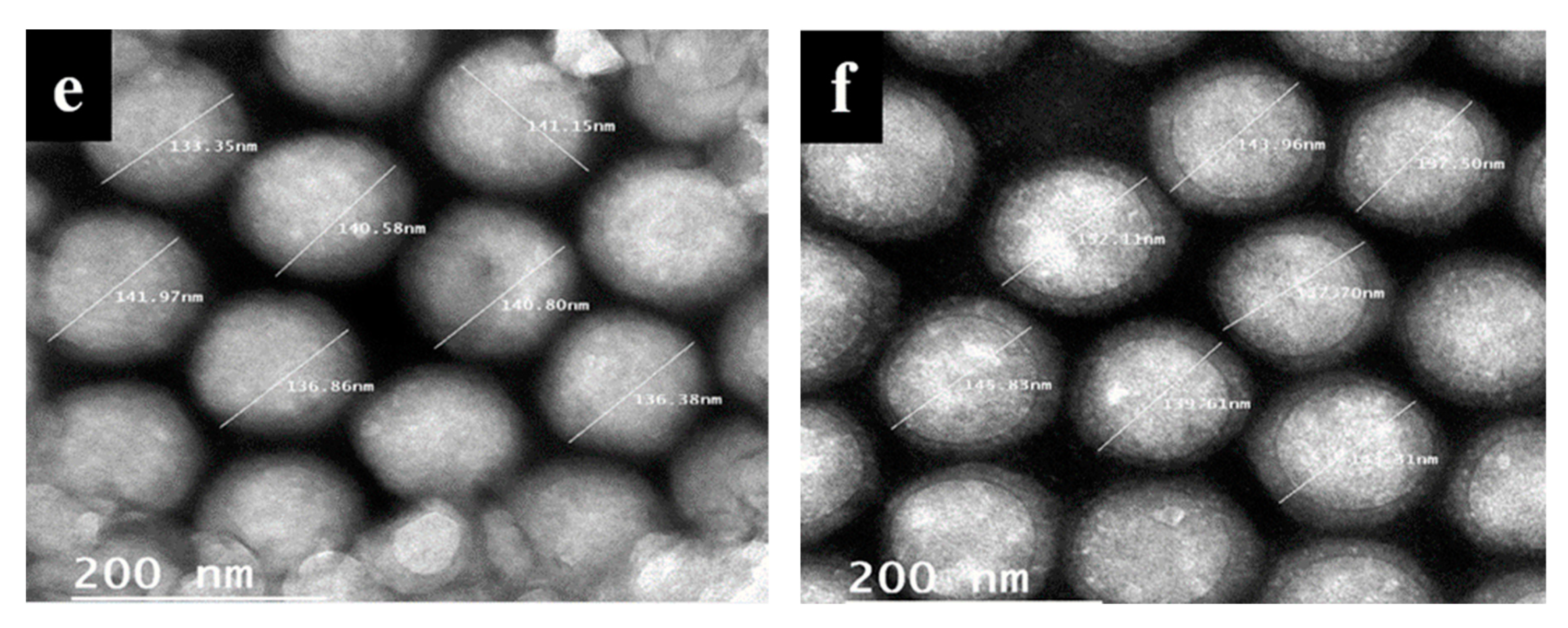
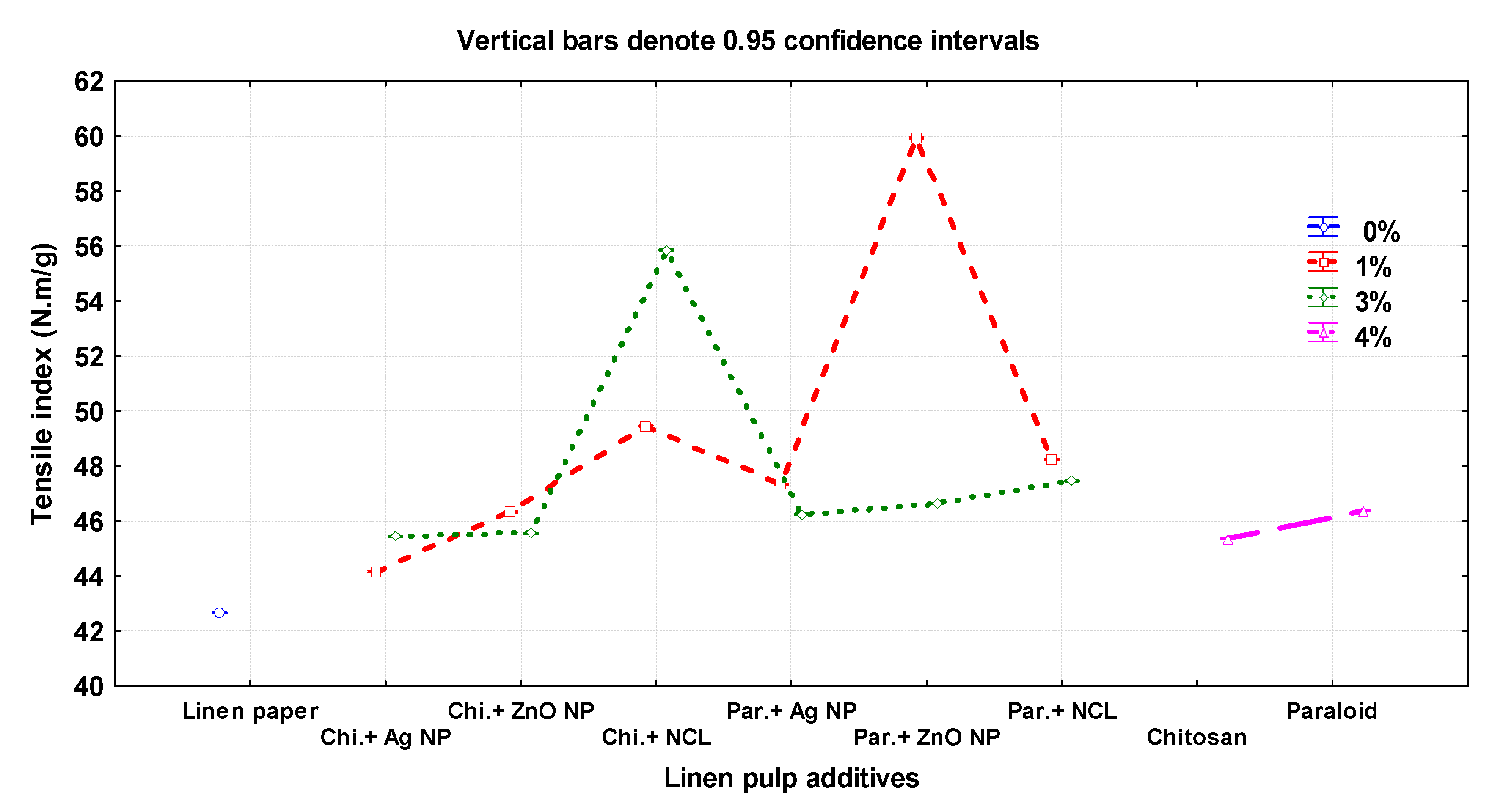
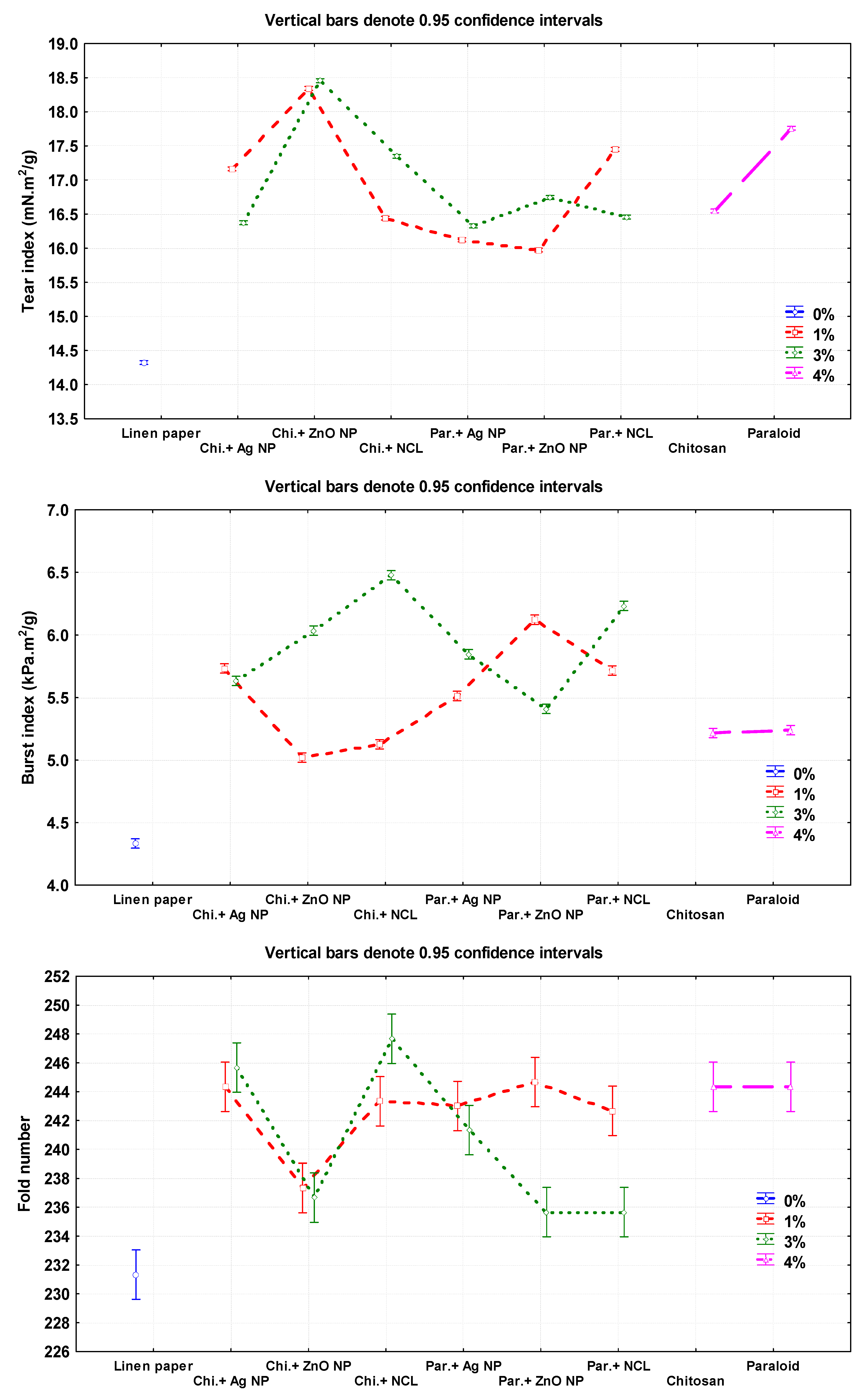
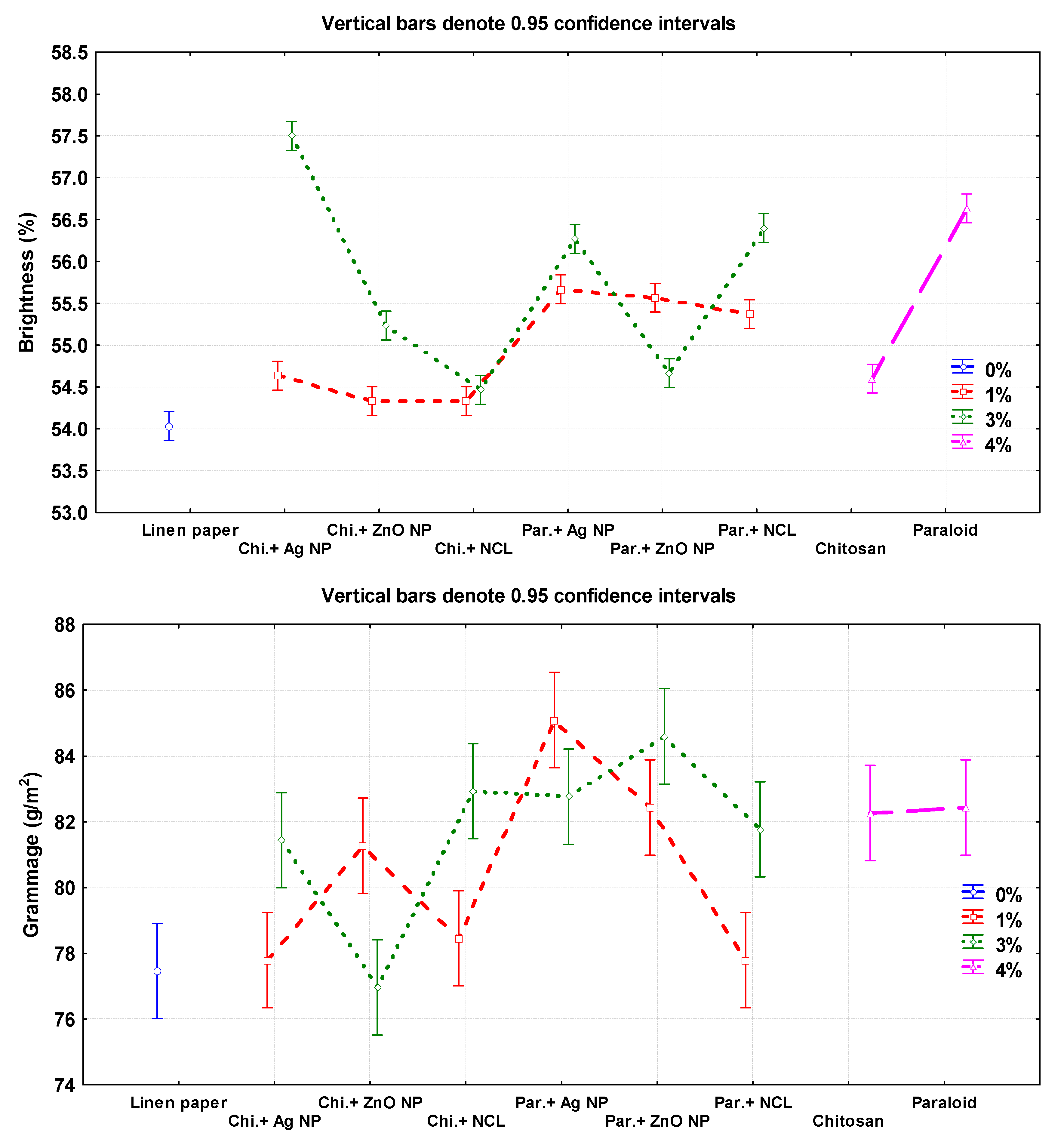



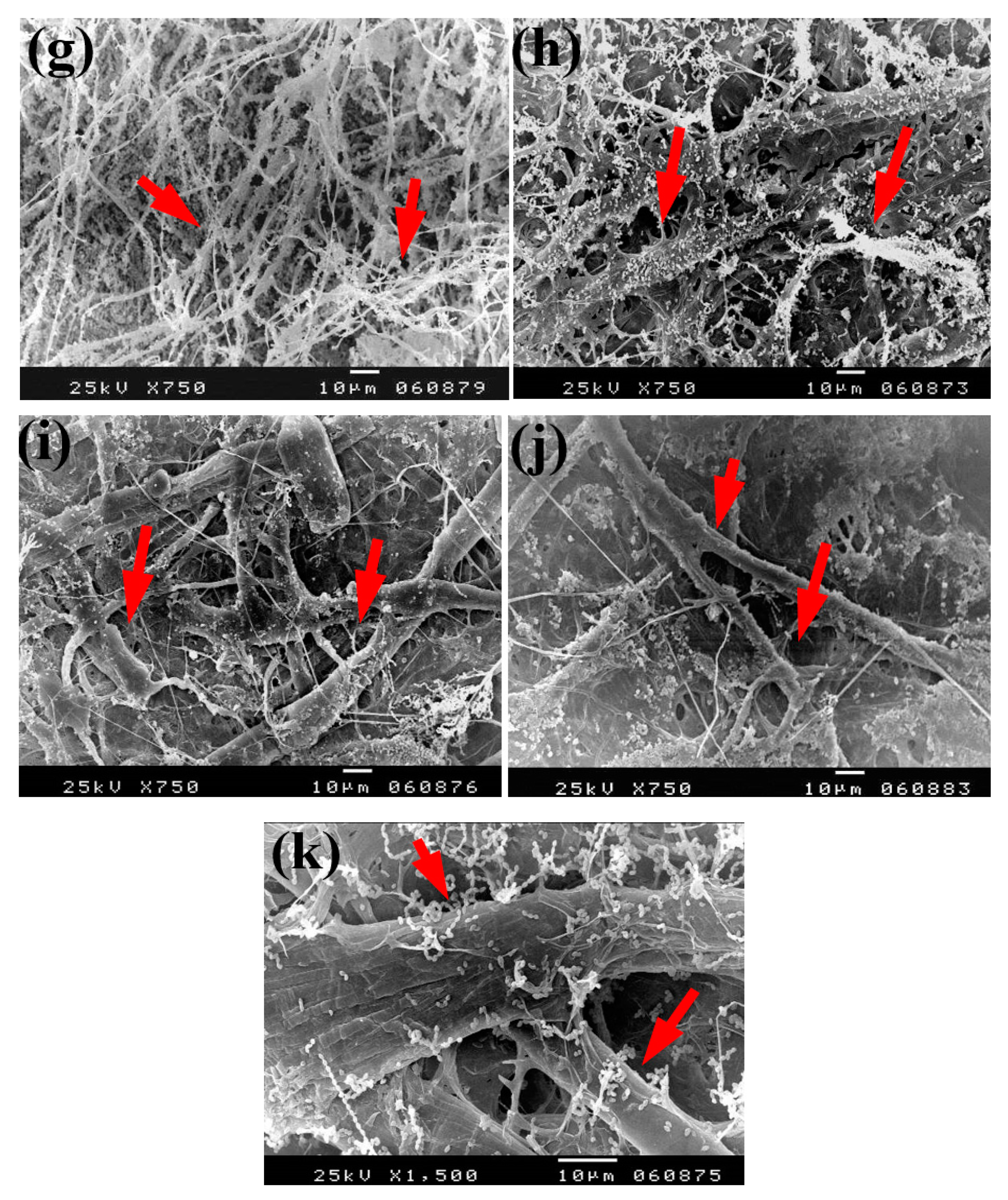
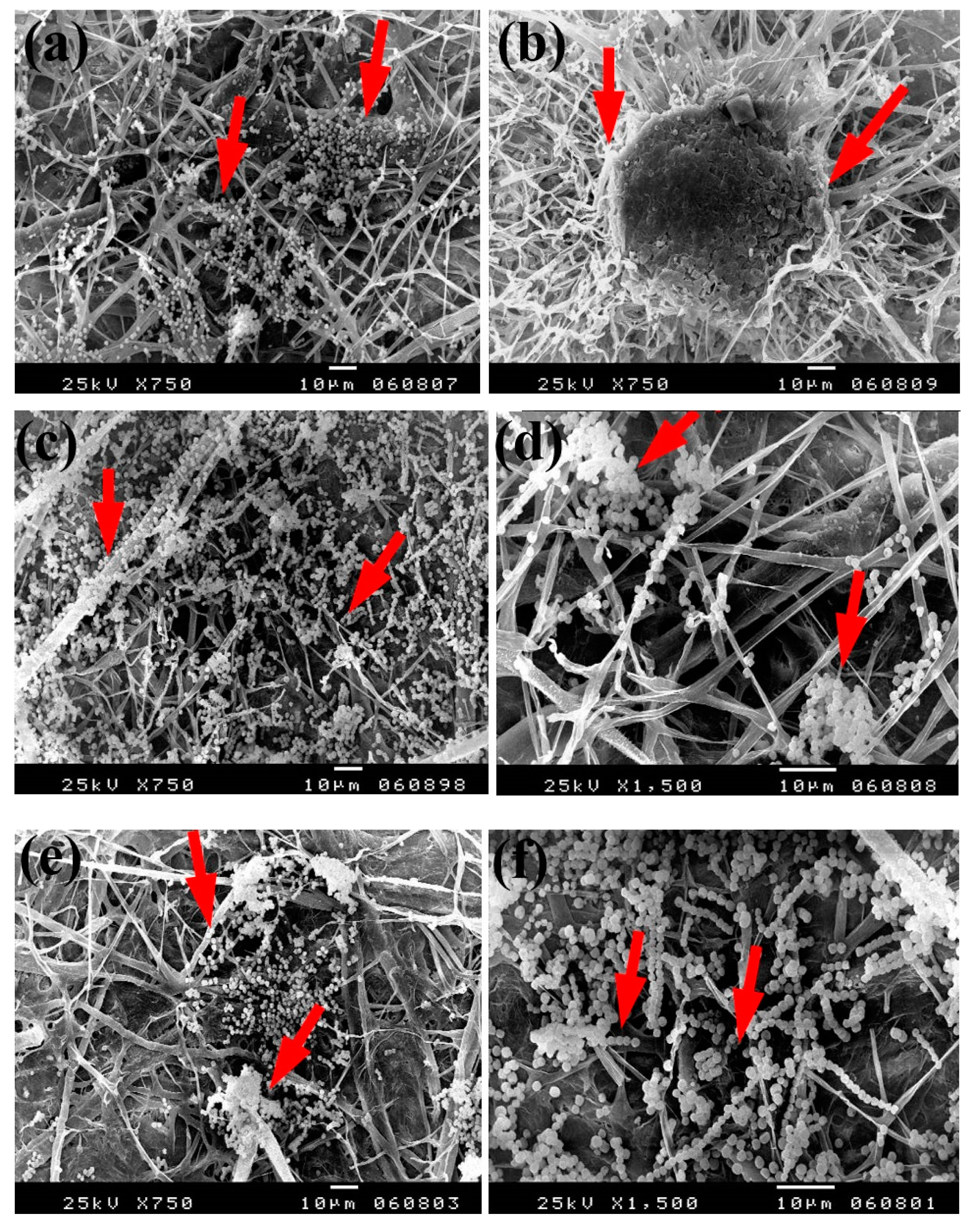
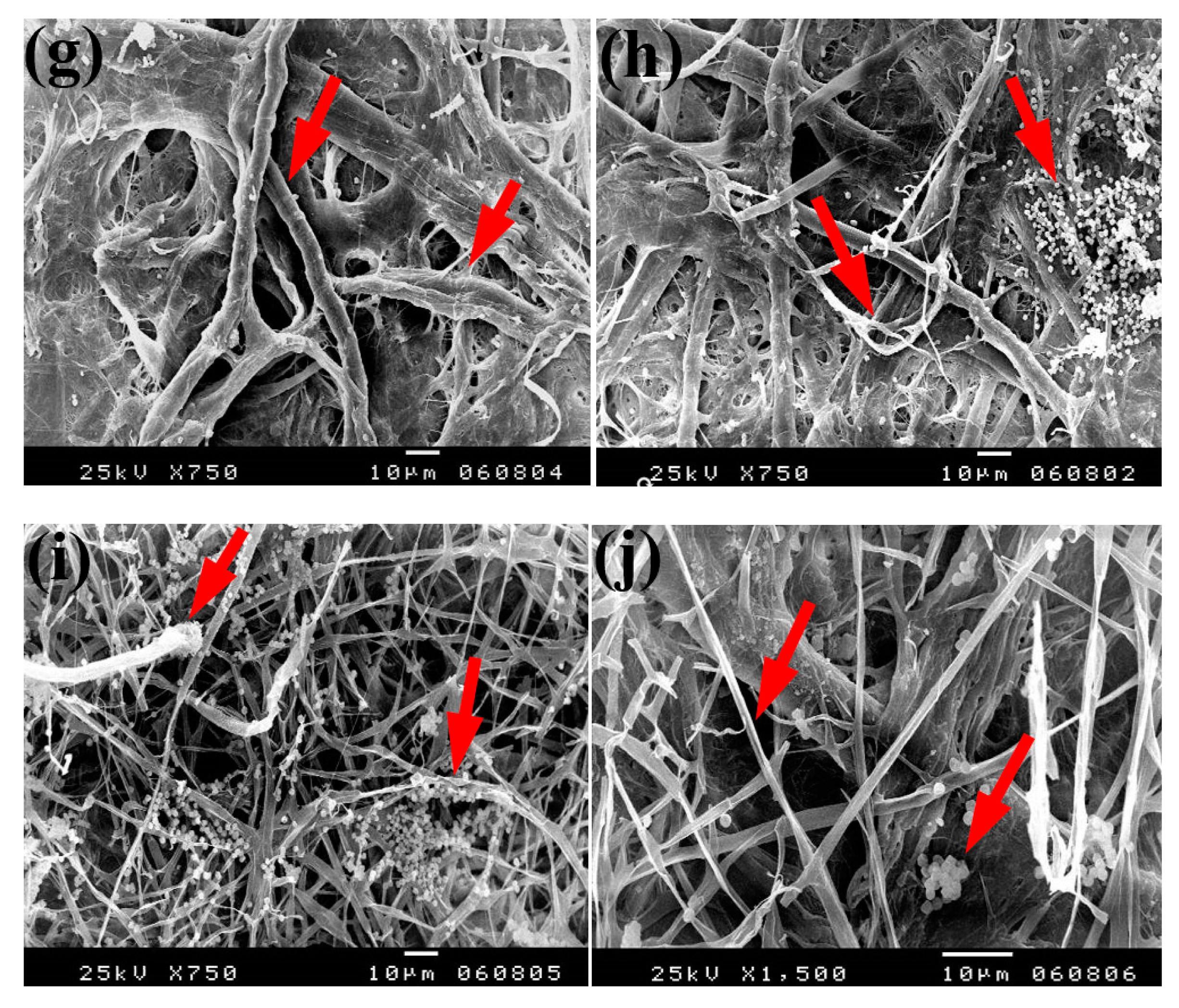
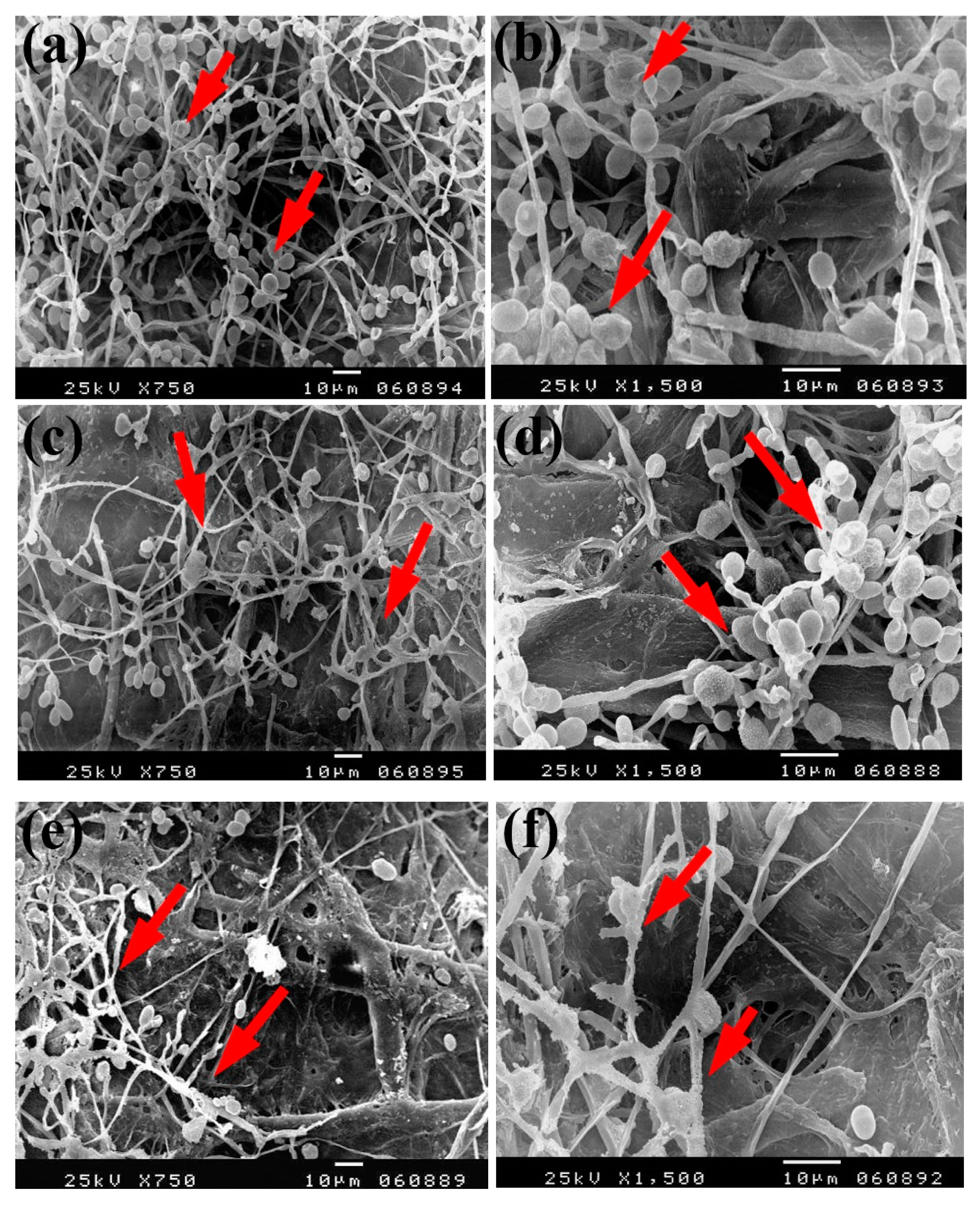
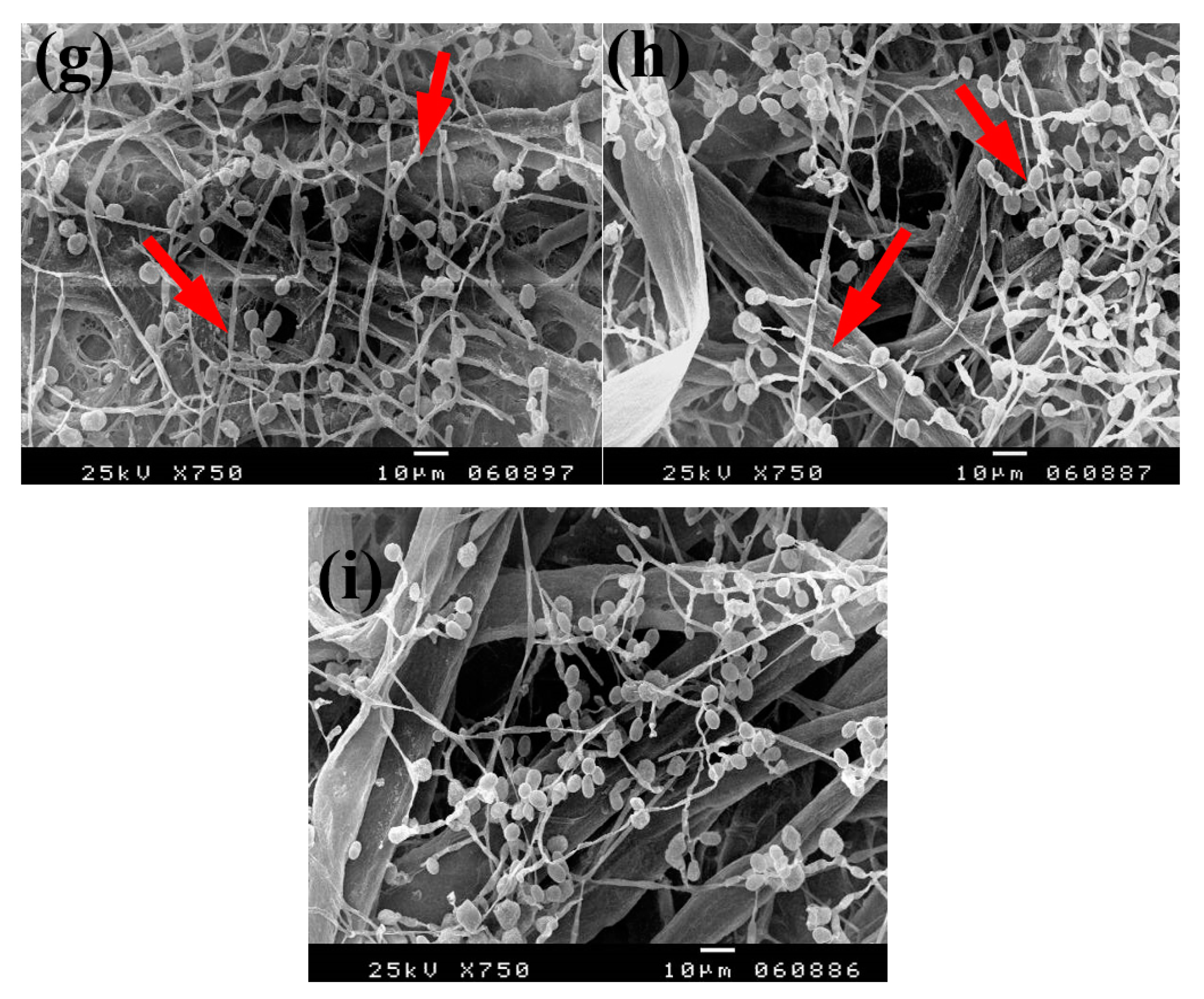
| Treatment | |
|---|---|
| 1 | Chitosan + Ag NP 1% |
| 2 | Chitosan + Ag NP 3% |
| 3 | Chitosan + ZnO NP 1% |
| 4 | Chitosan + ZnO NP 3% |
| 5 | Chitosan + NCL 1% |
| 6 | Chitosan + NCL 3% |
| 7 | Paraloid + Ag NP 1% |
| 8 | Paraloid + Ag NP 3% |
| 9 | Paraloid + ZnO NP 1% |
| 10 | Paraloid + ZnO NP 3% |
| 11 | Paraloid + NCL 1% |
| 12 | Paraloid + NCL 3% |
| 13 | Chitosan 4% |
| 14 | Paraloid B-72 4% |
| 15 | Pulp without additives |
| Test Machine | Specifications |
|---|---|
| Tensile Tester | Model: Adamel Lhomargy, model No. 596420, DY-30; Maximum load cell: 100 N display in Newton or KN; Digital display: 41/2 digits; Accuracy: 0.1%; Speed range: 0.01 to 999 mm/min, automatic return sped. |
| Tear Tester | Model: FRANK-PTI GMBH, Elmendorf tear tester, digital, Mod. 53984, Sr. 40551, Germany; Fully automatic model Available pendulums: 0–8000 mN; Compressed air 4–6 bar. |
| Burst Tester | Model: Tecnolab Company, model No. BS 20 E/SN. 160.08, Italy; Capacity 1999 kPa; Sensitivity 1 kPa; Accuracy ±0.5% kPa; Pump flow rate 95 ± 5 mL/min; Circular clamp diameter 65 mm; Diaphragm diameter 30.5 mm; Adjustable clamp pressure 0–90 psi; Air supply 6 bar max (90 psi). |
| Twin Folding Tester | Model: KÖGEL LEIPZIG, DFP 6-60; Standard tension of 9.81 N; Sample length: 100 mm; Sample width: 15 mm; Speed: 115 ± 10 strokes/min |
| Color Touch Model ISO | Model: Technidyne Corporation, New Albany Indiana USA, Model NO. CTH- ISO, Serial NO. CTH A 2054; Technidyne Corporation. |
| SOV | DF | Sum of Squares | Mean Square | F Value | Pr > F |
|---|---|---|---|---|---|
| Tensile index (N·m/g) | |||||
| Additives (A) | 6 | 383.552 | 63.925 | 198389 | <0.0001 |
| Concentrations (B) | 1 | 17.056 | 17.056 | 52935.2 | <0.0001 |
| A × B | 5 | 315.438 | 63.087 | 195789 | <0.0001 |
| Error | 30 | 0.0096 | 0.00032 | ||
| Corrected Total | 44 | 837.958 | |||
| Tear index (mN·m2/g) | |||||
| A | 6 | 20.284 | 3.3807 | 5828.86 | <0.0001 |
| B | 1 | 0.011 | 0.011 | 19.01 | <0.0001 |
| A × B | 5 | 4.608 | 0.922 | 1589.27 | <0.0001 |
| Error | 30 | 0.0174 | 0.0006 | ||
| Corrected Total | 44 | 44.703 | |||
| Burst index (kPa·m2/g) | |||||
| A | 6 | 0.668 | 0.112 | 110.02 | <0.0001 |
| B | 1 | 1.444 | 1.444 | 1425.00 | <0.0001 |
| A × B | 5 | 4.185 | 0.837 | 826.09 | <0.0001 |
| Error | 30 | 0.0304 | 0.001 | ||
| Corrected Total | 44 | 12.645 | |||
| Fold number | |||||
| A | 6 | 337 | 56.166 | 26.61 | <0.0001 |
| B | 1 | 40.111 | 40.111 | 19.00 | <0.0001 |
| A × B | 5 | 190.55 | 38.111 | 18.05 | <0.0001 |
| Error | 30 | 63.333 | 2.11 | ||
| Corrected Total | 44 | 985.20 | |||
| Brightness (%) | |||||
| A | 6 | 20.936 | 3.489 | 163.89 | <0.0001 |
| B | 1 | 5.359 | 5.359 | 251.71 | <0.0001 |
| A × B | 5 | 11.555 | 2.3111 | 108.55 | <0.0001 |
| Error | 30 | 0.638 | 0.0212 | ||
| Corrected Total | 44 | 44.07 | |||
| Grammage (gm/m2) | |||||
| A | 6 | 131.195 | 21.866 | 14.50 | <0.0001 |
| B | 1 | 14.554 | 14.554 | 9.65 | 0.0041 |
| A × B | 5 | 102.238 | 20.447 | 13.56 | <0.0001 |
| Error | 30 | 45.23 | 1.5077 | ||
| Corrected Total | 44 | 342.18 | |||
| Pulp Additives | Concentration (%) | Inhibition of Mycelial Growth (%) | ||
|---|---|---|---|---|
| Aspergillus flavus | Aspergillus terreus | Stemphylium solani | ||
| Chitosan + Ag NP | 1 | 1.48 ± 1.28 | 11.48 ± 0.64 | 0.74 ± 0.64 |
| 3 | 1.11 ± 1.11 | 8.51 ± 2.79 | 2.59 ± 1.28 | |
| Chitosan + ZnO NP | 1 | 1.85 ± 1.69 | 10.37 ± 0.64 | 1.85 ± 1.69 |
| 3 | 1.48 ± 1.28 | 2.59 ± 1.28 | 0.74 ± 0.64 | |
| Chitosan + NCL | 1 | 1.11 ± 1.11 | 10.74 ± 0.64 | 0.37 ± 0.64 |
| 3 | 0.74 ± 0.64 | 5.92 ± 0.64 | 2.22 ± 1.11 | |
| Paraloid B-72 + Ag NP | 1 | 0.37 ± 0.64 | 8.88 ± 1.11 | 3.7 ± 0.64 |
| 3 | 0.74 ± 1.28 | 9.62 ± 0.64 | 1.48 ± 1.28 | |
| Paraloid B-72 + ZnO NP | 1 | 0.37 ± 0.64 | 8.14 ± 1.69 | 0.37 ± 0.64 |
| 3 | 0.00 | 8.14 ± 1.28 | 1.85 ± 0.64 | |
| Paraloid B-72 + NCL | 1 | 0.37 ± 0.64 | 8.14 ± 1.28 | 0.37 ± 0.64 |
| 3 | 0.00 | 10.74 ± 0.64 | 0.74 ± 1.28 | |
| Without additives | 0 | 0.00 | 0.00 | 0.00 |
| Chitosan | 4 | 0.00 | 0.00 | 0.00 |
| Paraloid B-72 | 4 | 0.00 | 0.00 | 0.00 |
| p-value | ** | ** | ** | |
© 2020 by the authors. Licensee MDPI, Basel, Switzerland. This article is an open access article distributed under the terms and conditions of the Creative Commons Attribution (CC BY) license (http://creativecommons.org/licenses/by/4.0/).
Share and Cite
Abo Elgat, W.A.A.; Taha, A.S.; Böhm, M.; Vejmelková, E.; Mohamed, W.S.; Fares, Y.G.D.; Salem, M.Z.M. Evaluation of the Mechanical, Physical, and Anti-Fungal Properties of Flax Laboratory Papersheets with the Nanoparticles Treatment. Materials 2020, 13, 363. https://doi.org/10.3390/ma13020363
Abo Elgat WAA, Taha AS, Böhm M, Vejmelková E, Mohamed WS, Fares YGD, Salem MZM. Evaluation of the Mechanical, Physical, and Anti-Fungal Properties of Flax Laboratory Papersheets with the Nanoparticles Treatment. Materials. 2020; 13(2):363. https://doi.org/10.3390/ma13020363
Chicago/Turabian StyleAbo Elgat, Wael A. A., Ayman S. Taha, Martin Böhm, Eva Vejmelková, Wael S. Mohamed, Yahia G. D. Fares, and Mohamed Z. M. Salem. 2020. "Evaluation of the Mechanical, Physical, and Anti-Fungal Properties of Flax Laboratory Papersheets with the Nanoparticles Treatment" Materials 13, no. 2: 363. https://doi.org/10.3390/ma13020363
APA StyleAbo Elgat, W. A. A., Taha, A. S., Böhm, M., Vejmelková, E., Mohamed, W. S., Fares, Y. G. D., & Salem, M. Z. M. (2020). Evaluation of the Mechanical, Physical, and Anti-Fungal Properties of Flax Laboratory Papersheets with the Nanoparticles Treatment. Materials, 13(2), 363. https://doi.org/10.3390/ma13020363










